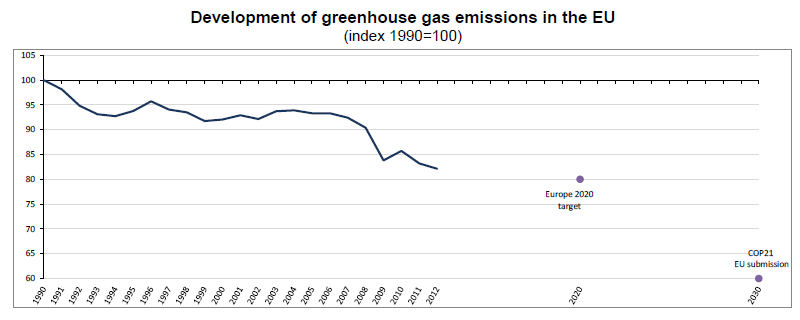Range of indicators monitors EU progress in tackling climate change
EU News 313/2015
4 November 2015
195/2015
Energy, transport and increased human intervention in the environment have proven to be major contributors to climate change over the last few decades. The European Union (EU) has actively been pursuing ambitious emission reduction targets for years. The UN Climate Change Conference taking place in Paris in December 2015 (COP21) illustrates the global political importance of climate change, energy security and sustainable transport, three topics that have become increasingly interconnected.
On the occasion of the publication of the 2015 Energy, transport and environment statistical book and with regard to the forthcoming COP21 in Paris, Eurostat, the statistical office of the European Union, publishes a small selection of data on energy, transport and environment in the EU related to climate change. These data show that while primary consumption of energy stood in 2013 at its early 1990s level, renewables have increased their share in final energy consumption and greenhouse gas emissions decreased over the same time period.
Largest reductions in greenhouse gas emissions in the Baltic EU Member States and Romania
Compared with 1990, most Member States reduced their greenhouse gas emissions by 2012. Emissions have more than halved in Latvia (-57.1%), Lithuania (-55.6%), Estonia (-52.6%) and Romania (-52.0%), followed by Bulgaria (-44.1%), Slovakia (-41.4%), Hungary (-36.3%) and the Czech Republic (-32.7%). In contrast, increases were registered in Malta (+56.9%), Cyprus (+47.7%), Spain (+22.5%), Portugal (+14.9%), Ireland (+7.0%), Greece (+5.7%), Austria (+4.0%) and Slovenia (+2.6%). At EU level, emissions were 17.9% below 1990 levels. While the EU is now confident of achieving its Europe 2020 target of cutting greenhouse gas emissions by 20% in 2020, it has recently doubled its objective in the context of the COP21, with at least a 40% reduction compared to 1990 levels to be achieved by 2030.
Greenhouse gas emissions in the EU as a whole stood in 2012 at 4 683 million tonnes of CO2 equivalent, with the biggest emitter being Germany (965 million), followed by the United Kingdom (615 mn), France (507 mn), Italy (471 mn), Poland (401 mn) and Spain (354 mn). Together, these six Member States generated around 70% of all greenhouse gas emissions in the EU in 2012.
Source and additional information:
http://ec.europa.eu/eurostat/documents/2995521/7057270/8-04112015-BP-EN.pdf/a233ec9d-f87d-4f48-8f1c-4d0a1a2eb112
Development of greenhouse gas emissions in the EU URL














